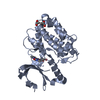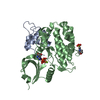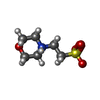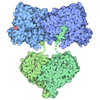+ Open data
Open data
- Basic information
Basic information
| Entry | Database: PDB / ID: 7b56 | ||||||
|---|---|---|---|---|---|---|---|
| Title | Crystal structure of CaMKII-actinin complex bound to AMPPNP | ||||||
 Components Components |
| ||||||
 Keywords Keywords |  STRUCTURAL PROTEIN / STRUCTURAL PROTEIN /  CaMKII / CaMKII /  actinin / actinin /  dendritic spine dendritic spine | ||||||
| Function / homology |  Function and homology information Function and homology informationregulation of synaptic vesicle docking / glutamatergic postsynaptic density / actin filament uncapping / FATZ binding / titin Z domain binding / HSF1-dependent transactivation / Interferon gamma signaling / Ion transport by P-type ATPases / phospholipase C-activating angiotensin-activated signaling pathway / positive regulation of endocytic recycling ...regulation of synaptic vesicle docking / glutamatergic postsynaptic density / actin filament uncapping / FATZ binding / titin Z domain binding / HSF1-dependent transactivation / Interferon gamma signaling / Ion transport by P-type ATPases / phospholipase C-activating angiotensin-activated signaling pathway / positive regulation of endocytic recycling / Unblocking of NMDA receptors, glutamate binding and activation / peptidyl-threonine autophosphorylation / positive regulation of potassium ion transmembrane transporter activity / regulation of endocannabinoid signaling pathway / negative regulation of potassium ion transmembrane transporter activity / Trafficking of AMPA receptors / calcium- and calmodulin-dependent protein kinase complex / RAF activation / calmodulin dependent kinase signaling pathway / Ca2+ pathway / RAF/MAP kinase cascade / calcium-dependent protein serine/threonine kinase activity / NMDA selective glutamate receptor signaling pathway /  regulation of neuron migration / regulation of neuron migration /  Ca2+/calmodulin-dependent protein kinase / positive regulation of cation channel activity / Ca2+/calmodulin-dependent protein kinase / positive regulation of cation channel activity /  LIM domain binding / negative regulation of protein localization to cell surface / regulation of neurotransmitter secretion / microspike assembly / postsynaptic actin cytoskeleton / dendritic spine development / muscle cell development / positive regulation of potassium ion transport / Ion homeostasis / positive regulation of calcium ion transport / postsynaptic specialization membrane / postsynaptic neurotransmitter receptor diffusion trapping / LIM domain binding / negative regulation of protein localization to cell surface / regulation of neurotransmitter secretion / microspike assembly / postsynaptic actin cytoskeleton / dendritic spine development / muscle cell development / positive regulation of potassium ion transport / Ion homeostasis / positive regulation of calcium ion transport / postsynaptic specialization membrane / postsynaptic neurotransmitter receptor diffusion trapping /  focal adhesion assembly / presynaptic cytosol / negative regulation of hydrolase activity / Assembly and cell surface presentation of NMDA receptors / Striated Muscle Contraction / calmodulin-dependent protein kinase activity / cardiac muscle cell development / Nephrin family interactions / GTPase activating protein binding / dendrite morphogenesis / regulation of mitochondrial membrane permeability involved in apoptotic process / sarcomere organization / regulation of neurotransmitter receptor localization to postsynaptic specialization membrane / postsynaptic cytosol / structural constituent of muscle / cortical actin cytoskeleton / Negative regulation of NMDA receptor-mediated neuronal transmission / positive regulation of cardiac muscle cell apoptotic process / Unblocking of NMDA receptors, glutamate binding and activation / regulation of neuronal synaptic plasticity / focal adhesion assembly / presynaptic cytosol / negative regulation of hydrolase activity / Assembly and cell surface presentation of NMDA receptors / Striated Muscle Contraction / calmodulin-dependent protein kinase activity / cardiac muscle cell development / Nephrin family interactions / GTPase activating protein binding / dendrite morphogenesis / regulation of mitochondrial membrane permeability involved in apoptotic process / sarcomere organization / regulation of neurotransmitter receptor localization to postsynaptic specialization membrane / postsynaptic cytosol / structural constituent of muscle / cortical actin cytoskeleton / Negative regulation of NMDA receptor-mediated neuronal transmission / positive regulation of cardiac muscle cell apoptotic process / Unblocking of NMDA receptors, glutamate binding and activation / regulation of neuronal synaptic plasticity /  pseudopodium / pseudopodium /  postsynaptic density, intracellular component / negative regulation of potassium ion transport / postsynaptic density, intracellular component / negative regulation of potassium ion transport /  Long-term potentiation / Long-term potentiation /  glutamate receptor binding / cellular response to interferon-beta / regulation of protein localization to plasma membrane / glutamate receptor binding / cellular response to interferon-beta / regulation of protein localization to plasma membrane /  titin binding / titin binding /  phosphatidylinositol-4,5-bisphosphate binding / ionotropic glutamate receptor signaling pathway / phosphatidylinositol-4,5-bisphosphate binding / ionotropic glutamate receptor signaling pathway /  regulation of membrane potential / Ras activation upon Ca2+ influx through NMDA receptor / regulation of membrane potential / Ras activation upon Ca2+ influx through NMDA receptor /  cytoskeletal protein binding / dendrite cytoplasm / nuclear receptor coactivator activity / platelet alpha granule lumen / cytoskeletal protein binding / dendrite cytoplasm / nuclear receptor coactivator activity / platelet alpha granule lumen /  filopodium / cell projection / response to ischemia / filopodium / cell projection / response to ischemia /  actin filament / protein localization to plasma membrane / angiotensin-activated signaling pathway / postsynaptic density membrane / G1/S transition of mitotic cell cycle / positive regulation of receptor signaling pathway via JAK-STAT / Schaffer collateral - CA1 synapse / Z disc / cellular response to type II interferon / calcium ion transport / actin filament / protein localization to plasma membrane / angiotensin-activated signaling pathway / postsynaptic density membrane / G1/S transition of mitotic cell cycle / positive regulation of receptor signaling pathway via JAK-STAT / Schaffer collateral - CA1 synapse / Z disc / cellular response to type II interferon / calcium ion transport /  actin filament binding / actin filament binding /  integrin binding / Platelet degranulation / integrin binding / Platelet degranulation /  cell junction / cell junction /  kinase activity / actin cytoskeleton organization / RAF/MAP kinase cascade / peptidyl-serine phosphorylation / regulation of apoptotic process / transmembrane transporter binding / kinase activity / actin cytoskeleton organization / RAF/MAP kinase cascade / peptidyl-serine phosphorylation / regulation of apoptotic process / transmembrane transporter binding /  dendritic spine / dendritic spine /  postsynaptic density / postsynaptic density /  cytoskeleton cytoskeletonSimilarity search - Function | ||||||
| Biological species |   Mus musculus (house mouse) Mus musculus (house mouse)  Homo sapiens (human) Homo sapiens (human) | ||||||
| Method |  X-RAY DIFFRACTION / X-RAY DIFFRACTION /  SYNCHROTRON / SYNCHROTRON /  MOLECULAR REPLACEMENT / Resolution: 1.45 Å MOLECULAR REPLACEMENT / Resolution: 1.45 Å | ||||||
 Authors Authors | Zhu, J. / Gold, M. | ||||||
 Citation Citation |  Journal: To Be Published Journal: To Be PublishedTitle: Crystal structure of CaMKII-actinin complex bound to MES Authors: Zhu, J. / Gold, M. | ||||||
| History |
|
- Structure visualization
Structure visualization
| Structure viewer | Molecule:  Molmil Molmil Jmol/JSmol Jmol/JSmol |
|---|
- Downloads & links
Downloads & links
- Download
Download
| PDBx/mmCIF format |  7b56.cif.gz 7b56.cif.gz | 216.8 KB | Display |  PDBx/mmCIF format PDBx/mmCIF format |
|---|---|---|---|---|
| PDB format |  pdb7b56.ent.gz pdb7b56.ent.gz | 140.9 KB | Display |  PDB format PDB format |
| PDBx/mmJSON format |  7b56.json.gz 7b56.json.gz | Tree view |  PDBx/mmJSON format PDBx/mmJSON format | |
| Others |  Other downloads Other downloads |
-Validation report
| Arichive directory |  https://data.pdbj.org/pub/pdb/validation_reports/b5/7b56 https://data.pdbj.org/pub/pdb/validation_reports/b5/7b56 ftp://data.pdbj.org/pub/pdb/validation_reports/b5/7b56 ftp://data.pdbj.org/pub/pdb/validation_reports/b5/7b56 | HTTPS FTP |
|---|
-Related structure data
| Related structure data |  7b55C  2vz6S S: Starting model for refinement C: citing same article ( |
|---|---|
| Similar structure data | Similarity search - Function & homology  F&H Search F&H Search |
- Links
Links
- Assembly
Assembly
| Deposited unit | 
| ||||||||||||
|---|---|---|---|---|---|---|---|---|---|---|---|---|---|
| 1 |
| ||||||||||||
| Unit cell |
|
- Components
Components
-Protein , 2 types, 2 molecules BA
| #1: Protein |  / CaMK-II subunit alpha / CaMK-II subunit alphaMass: 35903.430 Da / Num. of mol.: 1 Source method: isolated from a genetically manipulated source Source: (gene. exp.)   Mus musculus (house mouse) / Gene: Camk2a / Production host: Mus musculus (house mouse) / Gene: Camk2a / Production host:   Escherichia coli (E. coli) Escherichia coli (E. coli)References: UniProt: P11798,  Ca2+/calmodulin-dependent protein kinase Ca2+/calmodulin-dependent protein kinase |
|---|---|
| #2: Protein |  / Alpha-actinin skeletal muscle isoform 2 / F-actin cross-linking protein / Alpha-actinin skeletal muscle isoform 2 / F-actin cross-linking proteinMass: 7903.778 Da / Num. of mol.: 1 Source method: isolated from a genetically manipulated source Source: (gene. exp.)   Homo sapiens (human) / Gene: ACTN2 / Production host: Homo sapiens (human) / Gene: ACTN2 / Production host:   Escherichia coli (E. coli) / References: UniProt: P35609 Escherichia coli (E. coli) / References: UniProt: P35609 |
-Non-polymers , 4 types, 444 molecules 






| #3: Chemical | ChemComp-ANP / |
|---|---|
| #4: Chemical | ChemComp-MG / |
| #5: Chemical | ChemComp-MES /  MES (buffer) MES (buffer) |
| #6: Water | ChemComp-HOH /  Water Water |
-Details
| Has ligand of interest | Y |
|---|
-Experimental details
-Experiment
| Experiment | Method:  X-RAY DIFFRACTION / Number of used crystals: 1 X-RAY DIFFRACTION / Number of used crystals: 1 |
|---|
- Sample preparation
Sample preparation
| Crystal | Density Matthews: 2.45 Å3/Da / Density % sol: 49.85 % |
|---|---|
Crystal grow | Temperature: 277 K / Method: vapor diffusion, sitting drop Details: 0.1 M MES pH 6.0, 20% w/v PEG4000, 0.2 M Lithium Sulfate |
-Data collection
| Diffraction | Mean temperature: 100 K / Serial crystal experiment: N |
|---|---|
| Diffraction source | Source:  SYNCHROTRON / Site: SYNCHROTRON / Site:  Diamond Diamond  / Beamline: I04-1 / Wavelength: 0.9119 Å / Beamline: I04-1 / Wavelength: 0.9119 Å |
| Detector | Type: DECTRIS PILATUS3 S 6M / Detector: PIXEL / Date: Mar 1, 2020 |
| Radiation | Protocol: SINGLE WAVELENGTH / Monochromatic (M) / Laue (L): M / Scattering type: x-ray |
| Radiation wavelength | Wavelength : 0.9119 Å / Relative weight: 1 : 0.9119 Å / Relative weight: 1 |
| Reflection | Resolution: 1.45→92 Å / Num. obs: 77065 / % possible obs: 100 % / Redundancy: 12.1 % / Biso Wilson estimate: 22.55 Å2 / CC1/2: 0.999 / Rpim(I) all: 0.016 / Net I/σ(I): 18.5 |
| Reflection shell | Resolution: 1.45→1.47 Å / Num. unique obs: 3786 / CC1/2: 0.825 / Rpim(I) all: 0.522 |
- Processing
Processing
| Software |
| |||||||||||||||||||||||||||||||||||||||||||||||||||||||||||||||||||||||||||||||||||||||||||||||||||||||||
|---|---|---|---|---|---|---|---|---|---|---|---|---|---|---|---|---|---|---|---|---|---|---|---|---|---|---|---|---|---|---|---|---|---|---|---|---|---|---|---|---|---|---|---|---|---|---|---|---|---|---|---|---|---|---|---|---|---|---|---|---|---|---|---|---|---|---|---|---|---|---|---|---|---|---|---|---|---|---|---|---|---|---|---|---|---|---|---|---|---|---|---|---|---|---|---|---|---|---|---|---|---|---|---|---|---|---|
| Refinement | Method to determine structure : :  MOLECULAR REPLACEMENT MOLECULAR REPLACEMENTStarting model: 2VZ6 Resolution: 1.45→52.77 Å / SU ML: 0.1456 / Cross valid method: FREE R-VALUE / σ(F): 1.34 / Phase error: 22.2221 Stereochemistry target values: GeoStd + Monomer Library + CDL v1.2
| |||||||||||||||||||||||||||||||||||||||||||||||||||||||||||||||||||||||||||||||||||||||||||||||||||||||||
| Solvent computation | Shrinkage radii: 0.9 Å / VDW probe radii: 1.11 Å / Solvent model: FLAT BULK SOLVENT MODEL | |||||||||||||||||||||||||||||||||||||||||||||||||||||||||||||||||||||||||||||||||||||||||||||||||||||||||
| Displacement parameters | Biso mean: 30.22 Å2 | |||||||||||||||||||||||||||||||||||||||||||||||||||||||||||||||||||||||||||||||||||||||||||||||||||||||||
| Refinement step | Cycle: LAST / Resolution: 1.45→52.77 Å
| |||||||||||||||||||||||||||||||||||||||||||||||||||||||||||||||||||||||||||||||||||||||||||||||||||||||||
| Refine LS restraints |
| |||||||||||||||||||||||||||||||||||||||||||||||||||||||||||||||||||||||||||||||||||||||||||||||||||||||||
| LS refinement shell |
| |||||||||||||||||||||||||||||||||||||||||||||||||||||||||||||||||||||||||||||||||||||||||||||||||||||||||
| Refinement TLS params. | Method: refined / Origin x: 15.1121581365 Å / Origin y: -5.04463431322 Å / Origin z: -2.5044161769 Å
| |||||||||||||||||||||||||||||||||||||||||||||||||||||||||||||||||||||||||||||||||||||||||||||||||||||||||
| Refinement TLS group | Selection details: all |
 Movie
Movie Controller
Controller



 PDBj
PDBj


























